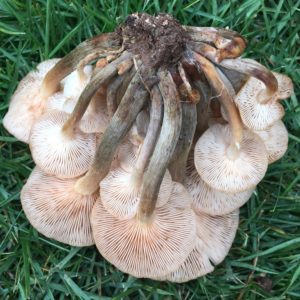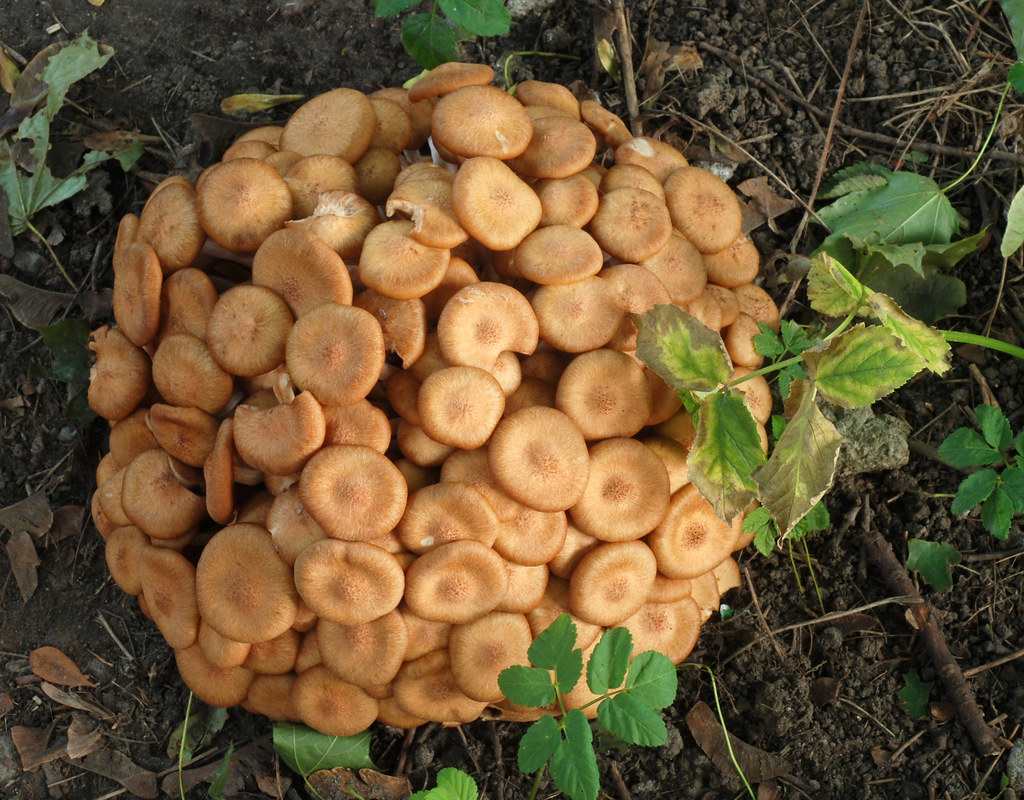The Ringless Honey Mushroom[i] is a small brown mushroom that feeds on living or dead tree roots and typically fruits in large clusters in which the stems of the mushrooms may be fused at their bases. Its season is late summer to early fall. They grow widely in North America and Europe, and perhaps elsewhere. Like other honey mushroom fungi, individuals of this species—meaning the underground organism that gives rise to the mushrooms—can get very large thanks to black, root-like structures that make transfer of nutrients through the fungal body more efficient. Patches of mushrooms dozens of yards apart may actually belong to the same individual. These root-like structures are seldom visible to collectors, however.
Honey mushrooms[ii] as a group may be characterized as either choice edibles or mildly toxic, depending on the authority consulted, since while many people do eat them with enjoyment, it’s not uncommon for some of those people to suffer gastrointestinal upset afterwards. Cooking reduces the chance of a bad reaction. The ringless honey is somewhat less sought-after than some of its relatives as its taste is not quite as good.
Preliminary studies have suggested that various honey mushroom species could be sources for medicinal substances. While very little work has been done on the ringless honey mushroom specifically, it is likely to carry at least some of the benefits of its relatives.
Ringless Honey Mushroom Identification & Description
Cap: Brownish or sometimes yellowish, about two inches across, becoming flat or slightly dented in the middle with age. There are dark scales on the surface, especially when young. The edge may be slightly lined. The flesh is whitish to tan and does not change color when bruised or sliced.
Gills: Pale, pinkish white, but can become pinkish or brownish, especially if bruised. Most of the gills extend partway down the top of the stem, though there are short, partial gills among them, too.
Stem: Up to about three inches long, thin and tapering to the bottom, smooth and pale near the top, becoming darker and slightly hairy below.
Smell: Not distinctive for identification purposes.
Taste: Can either be bitter or not distinctive for identification purposes.
Spores: Smooth, ellipsoid
Spore color: White
Edibility: Edible but with caution.
Habitat: Eats living or dead tree roots, especially those of oaks or maples. May appear to fruit directly from the ground, if the root is underground and far from its tree or stump.

As the name suggests, there is no ring or suggestion of a ring on the stem, nor does it ever grow on the trunk of a tree, as some of its relatives do.
Mushroom hunters say the ringless honey mushroom is the easiest honey mushroom to identify, but that is only because it is a very atypical honey. Beginners who cannot identify the specimen as a member of the honey group (the Armillarias) to begin with do not find the ringless easy to identify at all—and young specimens vaguely resemble the Deadly Galerina.
The very large, rapidly-growing clusters of this mushroom are a good hint at its identity, and at least make the fruiting bodies difficult to overlook.
Ringless Honey Mushroom Benefits
Although the ringless honey mushroom was not traditionally used for medicinal purposes, it does contain a substance, α-(1→6)-D-glucan, known to have anti-cancer properties[iii]. An extract of the fungus has also been shown—in in vitro testing—to be effective against several types of bacteria known to cause disease in humans[iv]. The ringless honey mushroom is also one of several mushroom species found to have antioxidant effects, and thus may have potential not simply in medicine but also as a source of food additives[v]. To be clear, the species is not currently used in medicine, and is not a popular health supplement. It simply has potential.
A close relative of the ringless honey mushroom, Armillaria mellea, has been more thoroughly researched and its potential medicinal benefits are much better-known. Although even closely-related species can be very different from each other biochemically, A. mellea does suggest possibilities for the ringless honey.
- mellea[vi] is the original honey mushroom, the first one to bear that common name. It, too, lives in both Europe and North America and can be a serious pest on trees. A complication is that multiple species have recently been split off from A. mellea and given their own scientific names on the basis of sexual incompatibility (yes, fungi can mate, but not when they’re members of different species), and some of these new species cannot be differentiated from each other except by testing sexual compatibility. Whether they also differ in what medicinal substances they have is unclear. Whether honey mushroom researchers have always correctly identified their subjects is also unclear. With that major caveat, in mind, the following discussion of the benefits of A. mellea should shed some light on the potential of A. tabescens.
Antioxidant Effects of A. mellea
Honey mushroom (A. mellia) is traditionally used in China for a number of complaints an in-vitro study examined the chemical constituents of the mushroom and identified several that have anti-oxidant and anti-edema effects[vii]. Another similar study identified both anti-oxidant substances and substances capable of lowering blood sugar[viii].
Anti-Cancer Properties of A. mellea
A series of in vitro tests showed than an extract of honey mushroom killed both human lymphoma cells and two different kinds of human liver cancer cells[ix]. Of course, for a substance to kill cancer in a dish is no proof that it can fight cancer in a person (without, for example, killing the patient’s other cells), but it does indicate a worthwhile avenue of research.
Neurological Health and A. mellea
A study involving mice who had been experimentally given a degenerative condition similar to Alzheimer’s Disease found that an extract of honey mushroom both improved the subjects’ performance on mazes and other tests and reduced characteristic signs of degeneration in their brains[x].
Antibiotic Properties of A. mellea
At least four antibiotic and anti-fungal substances were originally isolated from honey mushroom tissue[xi]. Whether the whole mushroom can deliver a therapeutic dose of any of the four when eaten seems unclear, however.
Ringless Honey Mushroom Dosage
Because the ringless honey mushroom is not currently used in medicine, the question of dosage does not apply.
Ringless Honey Mushroom Side Effects & Toxicity
Side effects in a specifically medicinal context are unknown, since the ringless honey is not generally used as medicine—the answer will likely depend on whether the whole mushroom is used or some kind of extract. Ringless honey mushroom is eaten, but, like other honey mushrooms, it must be eaten with caution if at all, since gastrointestinal upset is not unusual among people who partake. Proper cooking reduces, but does not necessarily eliminate, the chance of a bad reaction.
And the standard warnings for all mushrooms still apply; it’s important to be sure of the identity of the mushroom, because of the existence of toxic look-alikes, and persons who have never eaten ringless honey mushroom before should exercise moderation. With any food, allergies or sensitivities are possible, and it’s best to find out with a small dose.

My name is Austin Collins.
I've dedicated my life to Mushrooms.
I believe Mushrooms are the best kept secret when it comes to health and well being.
For that reason, I would like to share a company with you that in my opinion makes the best mushroom products on the market.
The company is called Noomadic Herbals, my favorite supplement they make is called "Mushroom Total".
I take their products every day and they have helped me think better and have more energy. Give them a try.
-Austin
References:
[i] Kuo, M. (2017). Armillaria tabescens. MushroomExpert website, accessed February 10, 2020.
[ii] Roehl, T. (2017), #198: Armillaria tabescens. Fungus Fact Friday website, accessed February 10, 2020.
[iii] De Silva, A.G.D., Rapior, S., Françoise, F., Bahkali, A., Hyde, K. (2012). Medicinal Mushrooms in Supportive Cancer Therapies: An Approach to Anti-cancer Effects and Putative Mechanisms of Action. Fungal Diversity 55(1): 1-35.
[iv] Herath, H.M.T.B., Jacon, M., Wilson, A. D., Abbas, H. K., Nanayakkara, N.P.D. (2013). New Compounds and Secondary Metabolites from Bioactive Extracts of the fungus Armillaria tabescens. National Product Research. 27(17): 1562- 1568.
[v] Tel, G., Deveci, E., Küçükaydin, S., Özler, M.A., Duru, M.E., Harmander, M. (2013). Evaluation of Antioxidant Activity of Armillaria tabescens, Leucopaxillus gentianeus, and Suillus granulatusL The Mushroom Species from Anatolia. Eurasian Journal of Analytical Chemistry.8(3): 136–147.
[vi] Kuo, M. (2017). Armillaria mellea. MushroomExpert website, accessed February 10, 2020,
[vii] Lai, M.N., Ng, L.T. (2013). Antioxidant and Antiedema Properties of Solid-State Cultured Honey Mushroom, Armillaria mellea (Higher Basidiomycetes) extracts and Their Polysaccharide and Polyphenol Contents. International Journal of Medicinal Mushrooms. 15(1): 1-8.
[viii] Zavastin, D.E., Mircea C., Aprotosoaie, A.C., Gherman, S., Hancianu, M., Miron, A. (2015). Armillaria mellia: Penolic Content, In Vitro Antioxidant and Antihyperglycemic Effects. Revista Medico-Chirurgicala a Societatii de Medici si Naturalisti din lasi. 119(1): 273-80.
[ix] Chen, Y., Chen, C., Huang, H.(2016). Induction of Apoptosis by Armillaria mellea Constituent Armillarikin in Human Hepatocellular Carcinoma. OncoTargets and Therapy. 9: 4773-4783.
[x] An, S., Lu, W., Zhang, Y., Yuan, Q., Wang, D. (2017). Pharmacological Basis for Use of Armillaria mellea Polysaccharides in Alzheimer’s Disease: Antiapoptosis and Antioxidation. Oxidative Medicine and Cellular Longevity. Article ID 4184562.
[xi] Oduro, K.A., Munnecke, DE., Sims, J.J., Keen, N.T. (1976). Isolation of Antibiotics Produced in Culture by Armillaria mellea. Transactions of the Brittish Mycological Society. 66(2): 195-199.




Found several clusters today of the Ringless honey mushrooms in my yard and this information helped. I dug them out and they were, in fact, located by the roots of trees that have been removed from my yard. The clusters were large and fast growing. This article was helpful to me as I have never seen or heard of this mushroom. Appreciated the picture and this article very much. Thank you.
How do you kill them? Or do you have to dig them up?
I don’t think I can support this 😂